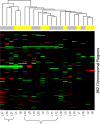Increased expression of cellular retinol-binding protein 1 in laryngeal squamous cell carcinoma
- PMID: 20054560
- PMCID: PMC11828092
- DOI: 10.1007/s00432-009-0735-9
Increased expression of cellular retinol-binding protein 1 in laryngeal squamous cell carcinoma
Abstract
Purpose: To investigate the genomic alterations in larynx carcinomas (LaCa) tissues and its prognostics values in predicting survival.
Methods: To analyse the aberrations in the genome of LaCa patients, we used array comparative genomic hybridization in 19 human laryngeal tumour samples. DNA samples were also subjected to detect human papillomavirus (HPV) sequences by polymerase chain reaction (PCR). Copy number gain was confirmed by real-time PCR. The cellular retinol-binding protein 1 (CRBP-1) gene expression was also confirmed by immunohistochemistry assay on LaCa tissues. To identify prognostic feature, CRBP-1 gene gain was correlated to patient survival.
Results: The most common gains were detected for CRBP-1 and EGFR genes, while DNA lost in RAF-1 gene. Immunohistochemistry assay was revealed strong expression of CRBP1 protein in those cases with CRBP-1 gene gain. The CRBP-1 gene gain and its expression correlated significantly with survival (P = 0.003). Cox regression analysis indicated that CRBP-1 expression level was a factor of survival (P = 0.008). HPV sequences were detected in 42% of the samples, and did not show any relationship with specific gene alterations.
Conclusion: Our data shows that CRBP-1 gene gain can be determined by immunohistochemistry on routinely processed tissue specimens, and could support as a potential novel marker for long-term survival in laryngeal squamous cell carcinoma.
Figures




Similar articles
-
Increased gene copy number of HER2 and concordant protein overexpression found in a subset of eyelid sebaceous gland carcinoma indicate HER2 as a potential therapeutic target.J Cancer Res Clin Oncol. 2016 Jan;142(1):125-33. doi: 10.1007/s00432-015-2009-z. Epub 2015 Jul 4. J Cancer Res Clin Oncol. 2016. PMID: 26141290 Free PMC article.
-
Can a Liquid Biopsy Detect Circulating Tumor DNA With Low-passage Whole-genome Sequencing in Patients With a Sarcoma? A Pilot Evaluation.Clin Orthop Relat Res. 2025 Jan 1;483(1):39-48. doi: 10.1097/CORR.0000000000003161. Epub 2024 Jun 21. Clin Orthop Relat Res. 2025. PMID: 38905450
-
Cost-effectiveness of using prognostic information to select women with breast cancer for adjuvant systemic therapy.Health Technol Assess. 2006 Sep;10(34):iii-iv, ix-xi, 1-204. doi: 10.3310/hta10340. Health Technol Assess. 2006. PMID: 16959170
-
LAPTM4B-35 overexpression is a risk factor for tumor recurrence and poor prognosis in hepatocellular carcinoma.J Cancer Res Clin Oncol. 2010 Feb;136(2):275-81. doi: 10.1007/s00432-009-0659-4. Epub 2009 Aug 19. J Cancer Res Clin Oncol. 2010. PMID: 19690886 Free PMC article.
-
Signs and symptoms to determine if a patient presenting in primary care or hospital outpatient settings has COVID-19.Cochrane Database Syst Rev. 2022 May 20;5(5):CD013665. doi: 10.1002/14651858.CD013665.pub3. Cochrane Database Syst Rev. 2022. PMID: 35593186 Free PMC article.
Cited by
-
Vitamin A, cancer treatment and prevention: the new role of cellular retinol binding proteins.Biomed Res Int. 2015;2015:624627. doi: 10.1155/2015/624627. Epub 2015 Mar 24. Biomed Res Int. 2015. PMID: 25879031 Free PMC article. Review.
-
High expression of cellular retinol binding protein-1 in lung adenocarcinoma is associated with poor prognosis.Genes Cancer. 2015 Nov;6(11-12):490-502. doi: 10.18632/genesandcancer.89. Genes Cancer. 2015. PMID: 26807202 Free PMC article.
-
ELOA promotes tumor growth and metastasis by activating RBP1 in gastric cancer.Cancer Med. 2023 Sep;12(18):18946-18959. doi: 10.1002/cam4.6516. Epub 2023 Sep 11. Cancer Med. 2023. PMID: 37694492 Free PMC article.
-
CRBP-1 over-expression is associated with poor prognosis in tongue squamous cell carcinoma.BMC Cancer. 2018 May 2;18(1):514. doi: 10.1186/s12885-018-4249-1. BMC Cancer. 2018. PMID: 29720147 Free PMC article.
-
Identification of prognostic immune genes in laryngeal cancer.J Int Med Res. 2020 Nov;48(11):300060520964662. doi: 10.1177/0300060520964662. J Int Med Res. 2020. PMID: 33147419 Free PMC article.
References
-
- Albertson D, Pinkel D (2003) Genomic microarrays in human genetic disease and cancer. Hum Mol Genet 12:R145–R152 - PubMed
-
- Almadori G, Cadoni G, Cattani P et al (1996) Detection of human papillomavirus DNA in laryngeal squamous cell carcinoma by polymerase chain reaction. Eur J Cancer 32A:783–788 - PubMed
-
- Almadori G, Cadoni G, Cattani P et al (2001) Human papillomavirus infection and epidermal growth factor receptor expression in primary laryngeal squamous cell carcinoma. Clin Cancer Res 7:3988–3993 - PubMed
-
- Atula S, Grenman R, Kujari H et al (1999) Detection of human papillomavirus (HPV) in laryngeal carcinoma cell lines provides evidence for a heterogenic cell population. Eur J Cancer 35:825–832 - PubMed
-
- Baeten JM, Richardson BA, Bankson DD et al (2004) Use of serum retinol-binding protein for prediction of vitamin A deficiency: effects of HIV-1 infection, protein malnutrition, and the acute phase response. Am J Clin Nutr 79:218–225 - PubMed
Publication types
MeSH terms
Substances
LinkOut - more resources
Full Text Sources
Research Materials
Miscellaneous

